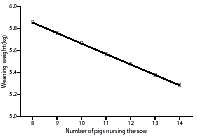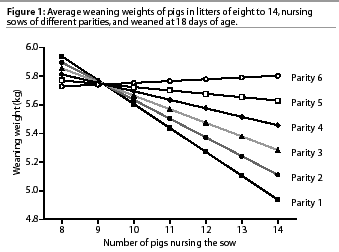What's your interpretation?
 A total of 2085 pigs from eight
commercial swine units in Ontario were weighed at birth and at
weaning. The weaning weights of individual pigs decreased as the
number of pigs nursing the sow increased. The figure shows this
relationship for a pig that weighed 1.7 kg at birth, nursed a
third parity sow, and was weaned at 18 days of age. Is this relationship
consistent across all parities?
A total of 2085 pigs from eight
commercial swine units in Ontario were weighed at birth and at
weaning. The weaning weights of individual pigs decreased as the
number of pigs nursing the sow increased. The figure shows this
relationship for a pig that weighed 1.7 kg at birth, nursed a
third parity sow, and was weaned at 18 days of age. Is this relationship
consistent across all parities?
Interaction between parity and the number of
pigs nursing the sow
Weaning weights depend on the number of pigs nursing the sow, the parity of the sow, and the interaction between these two factors. When weaning weights of individual pigs are examined, it is evident that the relationship between weaning weight and the number of pigs nursing the sow depends on the parity of the sow.
The equation for a 1.7 kg pig, weaned at 18 days of life is as follows:
Weaning weight = 7.6 - 0.2 (number of pigs nursing) - 0.36
(parity) + 0.0358
(parity x number of pigs nursing the sow)
Figure 1 illustrates the manner in which the relationship between weaning weight and the number of pigs nursing the sow depends on the parity of the sow. In an observational study, weaning weight did not differ among parity groups when the numbers of pigs nursing the sow was eight, nine, or ten. However, for litters of more than ten pigs, weaning weights were greater for the pigs nursed by older parity sows. This model predicts that litters of 11 to 14 pigs nursing parity one sows will have weaning weights between 5.4 and 4.9 kg. Weaning weights for the same litter size nursing parity two sows are not much better at 5.5 to 5.1 kg. The results of this study highlight the need to cross foster pigs at birth to even up litter sizes and maximize weaning weights. Nursing more than ten pigs has a negative impact on sows of all parities, but this impact is exaggerated in young parity sows. Therefore, older parity sows with large litters are likely to perform better than young parity sows with large litters.

-- Angel deGrau, DVM, DVSc;
Cate Dewey, DVM, MSc, PhD
Bob Friendship, DVM, MSc, Dip ABVP
Department of Population Medicine
Ontario Veterinary College
University of Guelph
Guelph, Ontario, Canada N1G 2W1
